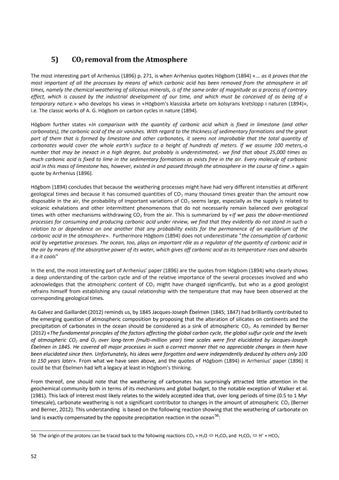5)
CO2 removal from the Atmosphere
The most interesting part of Arrhenius (1896) p. 271, is when Arrhenius quotes Högbom (1894) «... as it proves that the most important of all the processes by means of which carbonic acid has been removed from the atmosphere in all times, namely the chemical weathering of siliceous minerals, is of the same order of magnitude as a process of contrary effect, which is caused by the industrial development of our time, and which must be conceived of as being of a temporary nature.» who develops his views in «Högbom’s klassiska arbete om kolsyrans kretslopp i naturen (1894)», i.e. The classic works of A. G. Högbom on carbon cycles in nature (1894). Högbom further states «In comparison with the quantity of carbonic acid which is fixed in limestone (and other carbonates), the carbonic acid of the air vanishes. With regard to the thickness of sedimentary formations and the great part of them that is formed by limestone and other carbonates, it seems not improbable that the total quantity of carbonates would cover the whole earth's surface to a height of hundreds of meters. If we assume 100 meters,-a number that may be inexact in a high degree, but probably is underestimated,- we find that about 25,000 times as much carbonic acid is fixed to lime in the sedimentary formations as exists free in the air. Every molecule of carbonic acid in this mass of limestone has, however, existed in and passed through the atmosphere in the course of time .» again quote by Arrhenius (1896). Högbom (1894) concludes that because the weathering processes might have had very different intensities at different geological times and because it has consumed quantities of CO 2 many thousand times greater than the amount now disposable in the air, the probability of important variations of CO 2 seems large, especially as the supply is related to volcanic exhalations and other intermittent phenomenons that do not necessarily remain balanced over geological times with other mechanisms withdrawing CO 2 from the air. This is summarized by «If we pass the above-mentioned processes for consuming and producing carbonic acid under review, we find that they evidently do not stand in such a relation to or dependence on one another that any probability exists for the permanence of an equilibrium of the carbonic acid in the atmosphere». Furthermore Högbom (1894) does not underestimate "the consumption of carbonic acid by vegetative processes. The ocean, too, plays an important rôle as a regulator of the quantity of carbonic acid in the air by means of the absorptive power of its water, which gives off carbonic acid as its temperature rises and absorbs it a it cools" In the end, the most interesting part of Arrhenius’ paper (1896) are the quotes from Högbom (1894) who clearly shows a deep understanding of the carbon cycle and of the relative importance of the several processes involved and who acknowledges that the atmospheric content of CO 2 might have changed significantly, but who as a good geologist refrains himself from establishing any causal relationship with the temperature that may have been observed at the corresponding geological times. As Galvez and Gaillardet (2012) reminds us, by 1845 Jacques-Joseph Ébelmen (1845; 1847) had brilliantly contributed to the emerging question of atmospheric composition by proposing that the alteration of silicates on continents and the precipitation of carbonates in the ocean should be considered as a sink of atmospheric CO2. As reminded by Berner (2012) «The fundamental principles of the factors affecting the global carbon cycle, the global sulfur cycle and the levels of atmospheric CO2 and O2 over long-term (multi-million year) time scales were first elucidated by Jacques-Joseph Ébelmen in 1845. He covered all major processes in such a correct manner that no appreciable changes in them have been elucidated since then. Unfortunately, his ideas were forgotten and were independently deduced by others only 100 to 150 years later». From what we have seen above, and the quotes of Högbom (1894) in Arrhenius’ paper (1896) it could be that Ébelmen had left a legacy at least in Högbom’s thinking. From thereof, one should note that the weathering of carbonates has surprisingly attracted little attention in the geochemical community both in terms of its mechanisms and global budget, to the notable exception of Walker et al. (1981). This lack of interest most likely relates to the widely accepted idea that, over long periods of time (0.5 to 1 Myr timescale), carbonate weathering is not a significant contributor to changes in the amount of atmospheric CO2 (Berner and Berner, 2012). This understanding is based on the following reaction showing that the weathering of carbonate on land is exactly compensated by the opposite precipitation reaction in the ocean 56: 56 The origin of the protons can be traced back to the following reactions CO2 + H2O H2CO3 and H2CO3 H+ + HCO3-
52
